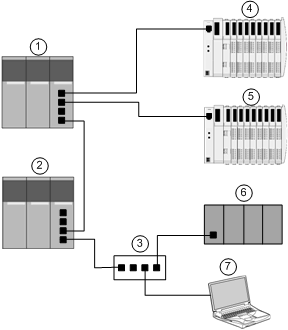Local Slave Networking Example
The Ethernet communication module supports up to three instances of the local slave functionality. The local slave functionality allows other scanners on the network to read from, and write to, the Ethernet communication module using implicit messaging. Each local slave instance can accept one exclusive owner connection and one listen only connection. Through a local slave, a remote scanner can access the communication module’s
CIP Assembly object. The local slave function is especially beneficial for peer to peer data exchanges at a repetitive rate.
NOTE:
-
The Ethernet communication module can provide three local slave adapter instances, while simultaneously performing as a scanner. These roles are not mutually exclusive.
-
The local slave is exclusively an EtherNet/IP functionality
In this example, the local slave instance is part of the following topology:
The sample configuration, above, includes the following devices:
-
A primary PLC (1) incorporating the BMX NOC 0401 Ethernet communication module with one local slave instance enabled. The PLC scans I/O data from remote devices (4 and 5)
-
A secondary PLC (2) that “listens” to the scan of the primary PLC’s local slave by the third-party PLC (6)
-
A managed Ethernet switch (3)
-
An Advantys STB island (4), with an STB NIC 2212 EtherNet/IP network interface module plus 8 I/O modules
-
An Advantys STB island (5), with an STB NIP 2212 Modbus TCP network interface module plus 8 I/O modules
-
A third party scanner (6)—which lacks adapter capability, and therefore cannot itself be scanned by the primary PLC (1)—that:
-
collects data from other sources (not part of this network)
-
writes data to inputs of the primary PLC’s local slave
-
scans the primary PLC’s local slave’s output data via an exclusive owner connection
-
A PC running the following software:
NOTE:
-
Because the third party scanner (6) and the secondary scanner (2) are both receiving the same data produced by the local slave, configure the requested packet interval (RPI) setting of the third party scanner’s exclusive owner connection and the secondary scanner’s listen only connection to the same setting.
-
By enabling a local slave on the primary PLC (1):
-
PLC (1) allows the third party PLC (6) to write to it at a repetitive rate, even if PLC (6) is not capable of acting as an adapter.
-
the secondary PLC (2) is able to scan the primary PLC (1) at a repetitive rate, rather than through application intensive explicit messaging.
The topics in this section show you how to use Control Expert software installed in the PC (7, above) to configure a local slave, and to create input and output items in support of the peer-to-peer data transfers between and among scanners.
